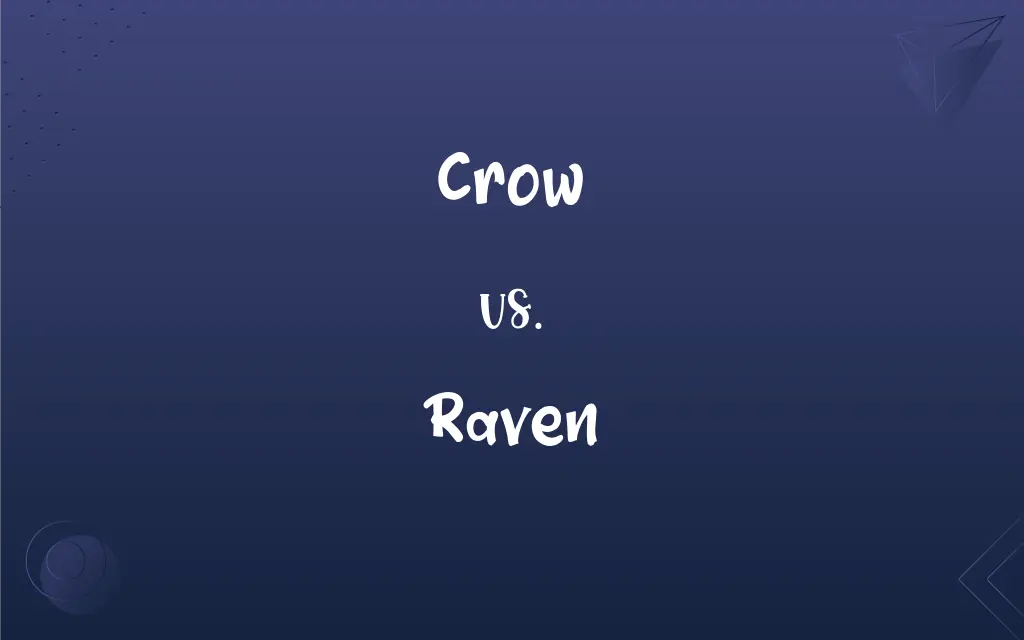Crow vs. Raven: What's the Difference?
Edited by Janet White || By Harlon Moss || Updated on July 1, 2024
Crows and ravens are both intelligent birds but differ in size, call sound, and some aspects of behavior and habitat; ravens are generally larger and have a deeper, croaking sound.

Key Differences
Crows and ravens, while often used interchangeably, harbor notable differences. Crows, generally smaller in stature, belong to the same family as ravens, known as Corvidae, yet present a modestly different visual and auditory profile. Ravens, on the other hand, not only stand out due to their larger size but also possess a distinctively different vocalization from crows. The former projects a deeper, croaking sound, which is starkly contrasted by the higher-pitched caw of crows. The tail feathers of ravens are wedge-shaped, divergent from the fairly straight line of a crow’s tail.
In an ecological context, crows often exhibit more adaptability to varied environments, including urban areas. Their resourceful nature enables them to exploit numerous food sources, embodying a versatility that is emblematic of their survival strategy. Crows can often be spotted in larger groups, which can sometimes create a communal atmosphere, especially during feeding.
Conversely, ravens tend to gravitate more towards wilder, less populated regions, though they are not exclusive to such areas. Notably solitary in comparison to crows, ravens often pair for life, demonstrating a fascinatingly loyal behavioral trait. Their interactions with humans tend to be less frequent, although ravens in certain geographical locales may exhibit higher adaptability to human presence.
Despite these differences, crows and ravens share an incredible intellect that has been a subject of various scientific studies. Their problem-solving abilities and utilization of tools stand as a testament to their cerebral prowess. Regardless of the distinctions, both birds have permeated cultural and mythological narratives across the globe, symbolizing various thematic elements from transformation to foreboding.
Comparison Chart
Size
Generally smaller
Larger and more robust
ADVERTISEMENT
Sound
Higher-pitched “caw”
Deeper, croaking sound
Tail Shape
Fairly straight or rounded
Wedge-shaped
Habitat
Adaptable, urban-friendly
Prefers wilder territories
Social Behavior
Often seen in groups
More solitary, pair bonds
Crow and Raven Definitions
Crow
A crow is a bird of the genus Corvus, known for its black plumage and intelligent behavior.
The crow deftly used a stick to extract food from the container.
ADVERTISEMENT
Raven
In literature, a raven can symbolize various concepts, including foreboding and mystery.
In the poem, the raven perched ominously above the chamber door, symbolizing never-ending sorrow.
Crow
Metaphorically, to “crow” can mean to boast or exult, typically in a triumphant manner.
After winning the game, he couldn’t resist the urge to crow about it to his friends.
Raven
A raven is a large, black bird known for its intelligence and is often found in the wild.
The raven soared above the mountain peaks, its black wings outstretched against the sky.
Crow
In certain contexts, “crow” refers to the act of expressing satisfaction or pleasure, especially vocally.
She couldn’t help but crow with delight upon hearing the good news.
Raven
As a verb, to “raven” means to seek plunder or prey.
Vikings were known to raven along the coasts, striking fear into the hearts of villagers.
Crow
In broader terms, a crow refers to any of various similar birds within the Corvidae family.
Different species of crows exhibit varied dietary preferences and behaviors.
Raven
“Raven” can also describe a jet-black color, especially regarding hair.
Her raven locks cascaded down her shoulders, shimmering under the moonlight.
Crow
As a verb, “crow” implies making a shrill sound characteristic of a rooster.
Every morning, the rooster crows at sunrise, signaling the start of a new day.
Raven
Additionally, “raven” as a verb can depict a voracious or eager devouring of food.
After the long hike, they ravened the hearty meal laid out before them.
Crow
A member of a Native American people formerly inhabiting an area of the northern Great Plains between the Platte and Yellowstone Rivers, now located in southeast Montana. The Crow became nomadic buffalo hunters after migrating west from the Missouri River in North Dakota in the 18th century.
Raven
A large bird (Corvus corax) of the Northern Hemisphere, having black plumage and a croaking cry.
Crow
The Siouan language of the Crow.
Raven
Any of several similar birds of the genus Corvus, found in Africa, Australia, and southwestern North America.
Crow
Any of several large glossy black birds of the genus Corvus, having a characteristic raucous call, especially C. brachyrhynchos of North America.
Raven
Variant of ravin.
FAQs
Are crows and ravens the same?
No, they have notable differences, including size and vocal sounds.
Are crows more likely to be found in urban areas than ravens?
Yes, crows are generally more adaptable to urban environments than ravens.
Which bird is larger, a crow or a raven?
Ravens are typically larger than crows.
How intelligent are ravens?
Ravens are highly intelligent, exhibiting problem-solving abilities and the use of tools.
Can crows recognize human faces?
Yes, studies have shown that crows can remember and recognize human faces.
What is a group of ravens called?
A group of ravens is typically referred to as an “unkindness” or “conspiracy.”
Can crows and ravens interbreed?
While they are closely related, crows and ravens do not typically interbreed in the wild.
Do crows travel in groups?
Yes, crows often move in groups known as “murders.”
Is it true that ravens can use tools?
Yes, ravens have been observed using tools in the wild and in experiments.
Can crows and ravens talk?
Both birds can mimic human speech and other sounds.
What do crows typically eat?
Crows are omnivorous and have a varied diet including small animals, fruits, and human food.
Are crows known to play?
Yes, crows have been observed engaging in playful behaviors.
Do crows interact with other animals?
Yes, crows have been observed interacting with various animals, both aggressively and playfully.
Do crows and ravens have different calls?
Yes, crows have a higher-pitched “caw,” while ravens produce a deeper, croaking sound.
Are crows and ravens protected by law?
Legal protections vary by location, but many places have laws protecting crows and ravens.
What is the common habitat of a raven?
Ravens are often found in wilder, more isolated habitats than crows.
Are ravens found all over the world?
Ravens are widespread and can be found in various environments across the Northern Hemisphere.
Is the raven a symbol of bad luck in some cultures?
Yes, in various cultures, ravens are sometimes associated with omens or bad luck.
What is the lifespan of a raven?
Ravens can live up to 40 years in the wild under optimal conditions.
Do ravens mate for life?
Yes, ravens often form lifelong pair bonds with their mates.
About Author
Written by
Harlon MossHarlon is a seasoned quality moderator and accomplished content writer for Difference Wiki. An alumnus of the prestigious University of California, he earned his degree in Computer Science. Leveraging his academic background, Harlon brings a meticulous and informed perspective to his work, ensuring content accuracy and excellence.
Edited by
Janet WhiteJanet White has been an esteemed writer and blogger for Difference Wiki. Holding a Master's degree in Science and Medical Journalism from the prestigious Boston University, she has consistently demonstrated her expertise and passion for her field. When she's not immersed in her work, Janet relishes her time exercising, delving into a good book, and cherishing moments with friends and family.































































